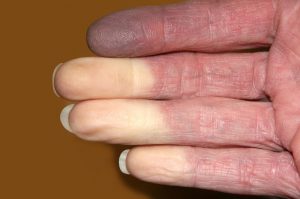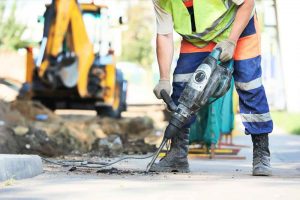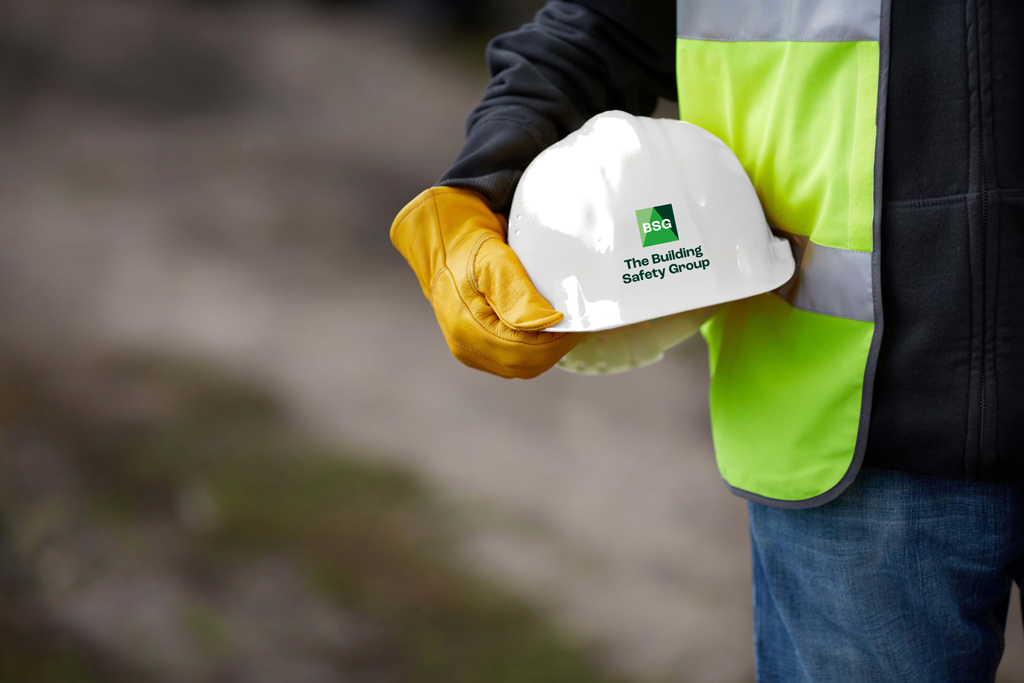05 April 2019
Getting to Grips with Vibration
BSG has reported a 33% year-on-year rise in the number of ‘Hand-Arm Vibration’ breaches recorded on construction sites. The increase is based on over 42,000 independent site inspections conducted over a two-year period, comparing 2017 to 2018.
Hand-arm vibration comes from the use of hand-held power tools and is the cause of significant ill health (painful and disabling disorders of the blood vessels, nerves and joints) and is a reportable industrial disease under Regulation 8 of The Reporting of Injuries, Diseases and Dangerous Occurrences Regulations 2013.
The health risks
 Hand-Arm Vibration Syndrome (HAVS) is preventable, but once the damage is done it is permanent. It is a serious and disabling condition with nearly two million people at risk. Between 2008 and 2017 there were over 7,000 new claims for HAVs according to the Industrial Injuries Disablement Benefit (IIDB).
Hand-Arm Vibration Syndrome (HAVS) is preventable, but once the damage is done it is permanent. It is a serious and disabling condition with nearly two million people at risk. Between 2008 and 2017 there were over 7,000 new claims for HAVs according to the Industrial Injuries Disablement Benefit (IIDB).
Damage from HAVS can include the inability to do fine work and cold can trigger painful finger blanching attacks. The early signs and symptoms to look out for are tingling and numbness in the fingers (which can cause sleep disturbance), not being able to feel things with fingers such as fine work or everyday tasks like fastening buttons, as well as loss of strength in the hands. In the cold and wet, the tips of fingers can go white then red, being painful on recovery (vibration white finger). If the use of high-vibration tools continues, these symptoms will probably get worse, e.g. the numbness in the hands could become permanent and the ability to feel things will be lost.
The law
The Control of Vibration at Work Regulations, which came into force in July 2005, focuses on the elimination or control of vibration exposure. They are designed to protect against risks to both health and safety from hand-arm vibration, i.e. the risk of HAVS and Carpal Tunnel Syndrome (CTS) in those exposed including situations where vibration may affect the ability to safely handle controls or read indicators, or where it may interfere with the stability or security of structures. The Regulations include an exposure action value (EAV) and an exposure limit value (ELV) based on a combination of the vibration at the grip point(s) on the equipment or work-piece and the time spent gripping it.
The exposure action and limit values are:
- A daily EAV of 2.5 m/s2 A(8) that represents a clear risk requiring management; and
- A daily ELV of 5 m/s2 A(8) that represents a high risk above which employees should not be exposed
During BSG’s site inspections, they found that the most common breaches were:
- Failing to make a suitable and sufficient assessment of the risk created by vibration in the workplace
- Failing to take into account the magnitude type and duration, the effects of vibration on operatives health
- Failing to provide suitable information, instruction and training to the operatives who are exposed to vibration
- Failing to provide information on trigger times for specific pieces of equipment
- Operatives are failing to monitor the extent of their exposure to vibration by not monitoring and recording trigger times
- Failing to obtain reliable information on the magnitude by relying on manufacturer published data, which is often unreliable and does not reflect the way the tool is used on site
Chris Chapman, BSG’s Technical Support Manager advises on how businesses can comply.
Carry out a risk assessment
 Regulation 5 requires employers who carry out work, which is liable to expose any of their employees to risk from vibration, to make a suitable and sufficient assessment of the risk created by that work to the health and safety of those employees.
Regulation 5 requires employers who carry out work, which is liable to expose any of their employees to risk from vibration, to make a suitable and sufficient assessment of the risk created by that work to the health and safety of those employees.
The risk assessment must identify the measures that need to be taken to meet the Regulation requirements.
Magnitude type and duration
The factors which govern a person’s daily vibration exposure are the magnitude (level) of vibration and the length of time the person is exposed to it. The greater the magnitude and/or the longer the duration of exposure, the greater the person’s vibration exposure will be. Other characteristics of the vibration, such as the frequency, may also affect the risk. These are dependent on how the equipment operates, e.g. hammer action tools and rotary action tools have very different vibration characteristics. The pattern of work may also be relevant, e.g. intermittent exposures may indicate a lower risk than a long, uninterrupted exposure.
Information, instruction and training
Employees should be properly trained to carry out their jobs safely.
Employers should ensure their workforce fully understands:
- The level of risk they may be exposed to, how it is caused and the possible health effects
- Which work equipment and processes cause vibration risks and their respective levels of risk
- How their personal daily exposures compare with the exposure action and limit values
- What symptoms of ill health they should look out for, to whom they should report them and how to report them
- What control measures are in place to reduce risks
- The use of personal protective equipment where required, e.g. the need to keep warm
- What training is planned for operators, supervisors and managers in their respective roles to ensure control of exposure, e.g. through correct selection, use and maintenance of equipment or restriction of exposure times
- What health surveillance will be provided, how it will be provided and why it is important, as well as the overall findings
Trigger times for equipment
Measurement of vibration requires specific competency, including training in how to use specialised measuring equipment. A good understanding is needed of the Regulations and the factors which can lead to inaccurate and misleading measurement. Businesses may arrange for a member of staff to undergo training in HAV measurement and assessment or employ a contractor with suitable qualifications and/or experience and an understanding of these Regulations to do the measurement.
Hand-arm vibration measurements should be made with a transducer firmly attached to the vibrating surface. Hand-held mounts are not generally recommended but may be used with care to ensure there is good and continuous contact with the vibrating surface. Any measurement away from the palm of the hand or where the measurement position is on the back of the hand, fingers or wrist is unlikely to provide a reliable measurement.
If a hand-arm vibration measurement system is to be used then it should measure according to the requirements of BS EN ISO 5349-1: 2001. This standard specifies that vibration measurements shall be made on the vibrating surface at the point where the vibration enters the hand (or hands). In addition to the measurement methodology standard, any equipment used to measure hand-arm vibration magnitudes should comply with BS EN ISO 8041:2005.
There is currently no wrist or glove mounted device which measures vibration suitable for use in a vibration risk assessment. Some devices on the market are simply “tool timers” and these do not have to be mounted on the tool as long as it is capable of logging all of the time each tool is in use and the individual’s total vibration exposure using vibration magnitude data from a reliable source that gives representative data of the tool, handle or workpiece in use.
Record trigger times
 It is important that employees who are exposed to the risks from exposure to vibration are aware of their duties, which are to follow instructions they are given on safe working practices, report problems with their equipment such as unusually high vibration levels and co-operate with the programme of control measures and health surveillance.
It is important that employees who are exposed to the risks from exposure to vibration are aware of their duties, which are to follow instructions they are given on safe working practices, report problems with their equipment such as unusually high vibration levels and co-operate with the programme of control measures and health surveillance.
Do not rely on manufacturers’ data
To be relevant, the vibration information used to carry out a vibration assessment needs to match as closely as possible to the likely vibration performance of the equipment. Manufacturers and suppliers have duties under the Supply of Machinery (Safety) Regulations to provide health and safety information in equipment handbooks. They also have a duty to list the vibration emission in literature describing equipment performance.
This is not always suitable for estimating vibration exposure as the HSE has stated that this type of information is often unreliable and does not reflect the way in which the tool is used and could therefore lead to inaccurate calculations of exposure. The HSE’s guidance book Hand-arm Vibration (L140) contains a table of examples of vibration magnitudes that have been measured by HSE on tools in real work situations. The table published in L140 has been updated and is available on the HSE website under the heading “Sources of Vibration Magnitude data”.
Take action
Once the level of exposure has been determined the data gathered can be used to take positive action by reducing the exposure and the risks such as:
- Changing the work process to avoid the need to use hand tools
- Modify the work to improve ergonomics
- Changing to better tools with lower vibration and good ergonomic design
- Maintaining and looking after the tools and consumables
- Training the workforce – employees should be properly trained to carry out their jobs safely
Make sure the action taken results in real changes – monitor systems and make sure work instructions are being followed.
Health surveillance
Don’t forget health surveillance for workers at risk, to pick up early signs of ill-health. Health surveillance should be provided for vibration exposed employees who are likely to be regularly exposed above the action value. Health surveillance is about having procedures to detect work-related ill health at an early stage and acting on the results. The main aims are to safeguard the health of employees (including identifying and protecting people at increased risk), and also to check the long-term effectiveness of control measures.
In the case of hand-arm vibration, one of the specific aims is to prevent employees from developing an advanced stage of HAVS. It is possible that employees who are exposed to vibration may have mild symptoms of HAVS. If they are not aware that they have the disease, health surveillance can help them to recognise that the first symptoms of HAVS have started to develop.
A simple approach to health surveillance involves working through a number of stages. The ‘tiered’ system works as follows:
Tier 1
Tier 1 is a short questionnaire used as the first check for people moving into jobs involving exposure to vibration. The replies to the questionnaire will indicate whether they need to be referred to Tier 3 for a HAVS health assessment.
Tier 2
Tier 2 is an annual screening questionnaire issued once a year to employees exposed to vibration risks to check whether they need to be referred to Tier 3 for a HAVS health assessment.
Tier 3
Tier 3 involves a HAVS health assessment by a qualified person (e.g. an occupational health nurse). If the assessment shows that the employee has HAVS, Tier 4 will apply.
Tier 4
Tier 4 involves a formal diagnosis and is carried out by a doctor qualified in occupational health. The doctor will advise you on the employee’s fitness for work.
Tier 5
Tier 5 is optional and involves referral of the employee for certain tests for HAVS. The results may help the doctor assess fitness for work.
Completed questionnaires should be sorted and referrals handled in house by the business appointed responsible person. This person need not be qualified but should have received training from an occupational health professional. However, it may be appropriate for the questionnaires to be treated as confidential and returned to suitably competent health professionals.
In the first instance, any employee reporting symptoms should be referred to a ‘qualified person’ for clinical assessment (Tier 3). The qualified person can make an informed assessment of the nature of reported symptoms on the basis of a confidential interview and limited medical examination.
employee reporting symptoms should be referred to a ‘qualified person’ for clinical assessment (Tier 3). The qualified person can make an informed assessment of the nature of reported symptoms on the basis of a confidential interview and limited medical examination.
An employee with HAVS should be reassessed at regular intervals and may need additional investigations in order to detect any progression of the disease. If no symptoms are reported on the screening questionnaire there is no need to refer the employee for further assessment. But they should complete the simple questionnaire again on an annual basis (Tier 2). HSE recommends that after three years of a vibration-exposed employee reporting no symptoms they should be referred for a consultation with an occupational health nurse.
Employers can be told about an individual employee being diagnosed with HAVS as long as the employee gives their consent. The qualified person can give advice about any recommended restrictions that relate to the employee’s job. Even if the individual does not give consent for medical information to be passed on, businesses should receive advice on fitness for work with exposure to vibration for each employee undergoing health surveillance.
This article can also be viewed in Health & Safety International Magazine



